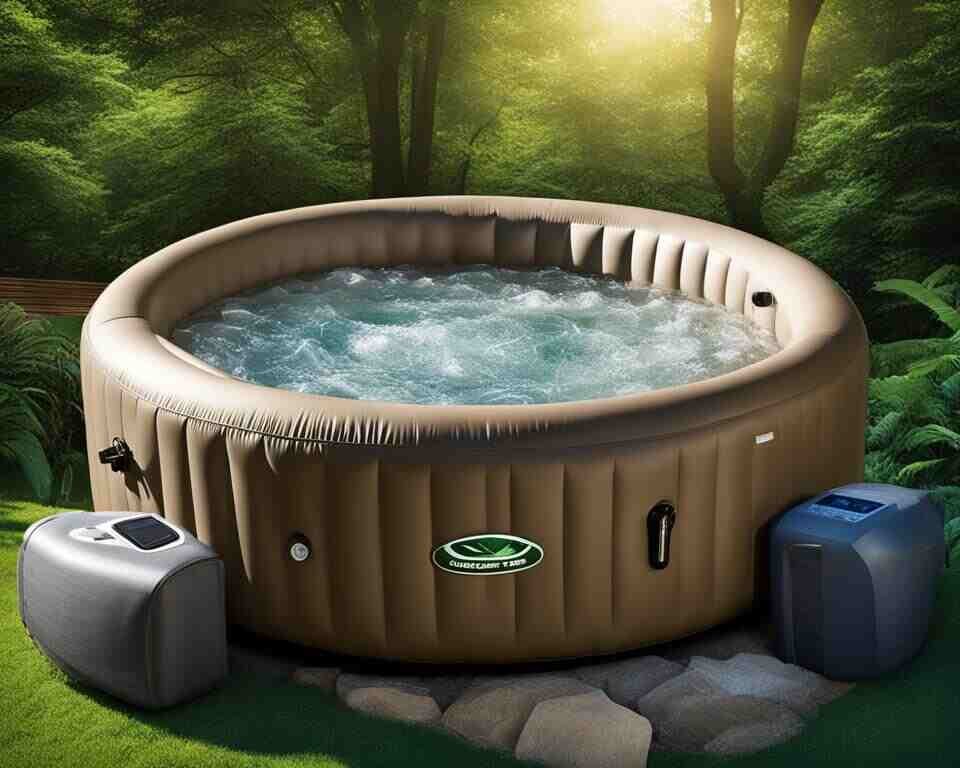Welcome to my comprehensive guide on understanding the running costs associated with inflatable hot tubs. If you are considering purchasing an inflatable hot tub, it’s important to be aware of the financial implications and maintenance expenses that come with it.
So, how much do inflatable hot tubs cost to run in 2023/24? Well, in this article, I will break down the cost to run inflatable hot tubs, discuss monthly maintenance costs, analyze electricity usage, and offer tips on reducing energy consumption.
By the end, you’ll have a clear understanding of the affordability and ongoing expenses of owning an inflatable hot tub.
Key Takeaways:
- Understanding the running costs of inflatable hot tubs is crucial before making a purchase decision.
- Initial investment, monthly maintenance costs, and electricity usage are key factors to consider.
- Comparing the affordability to traditional hot tubs can help you determine the best choice for your budget.
- Reducing energy consumption through smart practices can lead to long-term cost savings.
- Regular maintenance and care are essential for the longevity of your inflatable hot tub.

Understanding the Initial Investment in Inflatable Hot Tubs
In this section, I will discuss the initial investment required for inflatable hot tubs. I will compare the affordability of inflatable hot tubs to traditional hot tubs and provide information on popular models and their price ranges.
Affordability Compared to Traditional Hot Tubs
When considering purchasing a hot tub, one of the essential factors to consider is affordability. Inflatable hot tubs offer a more budget-friendly option compared to traditional hot tubs. The initial investment in an inflatable hot tub is significantly lower, making it a more accessible choice for many homeowners.
Traditional hot tubs can cost several thousands of dollars, and that’s just for the basic models. On the other hand, inflatable hot tubs are much more affordable, with prices ranging from a few hundred to around a thousand dollars, depending on the size, features, and brand.
This cost comparison makes inflatable hot tubs a more attractive option for individuals looking to enjoy the benefits of a hot tub without breaking the bank.
Popular Models and Their Price Ranges
Now, let’s explore some popular inflatable hot tub models and their price ranges. It’s important to note that prices may vary depending on the retailer and any ongoing promotions. However, I’ll provide you with a general idea of the cost of these models:
| Model | Price Range |
|---|---|
| Intex PureSpa | $800 – $1500 |
| Coleman SaluSpa | $460 – $1140 |
| Bestway Lay-Z-Spa | $400 – $900 |
These are just a few examples of popular inflatable hot tub models available in the market. Each model offers different features and specifications, allowing you to choose the one that suits your preferences and budget.
In the next sections, we’ll delve further into the running costs and maintenance expenses associated with inflatable hot tubs, providing you with a comprehensive overview of the financial aspects of owning one.
How Much Do Inflatable Hot Tubs Cost to Run?
When considering the purchase of an inflatable hot tub, it’s important to understand the cost of running and maintaining it. This section will provide detailed information on the monthly operating expenses, electricity usage, and average monthly cost of running an inflatable hot tub.
By gaining insight into these factors, you can make an informed decision and assess the affordability of owning an inflatable hot tub.
One of the main ongoing expenses of running an inflatable hot tub is the electricity usage. The heating element is typically the most energy-intensive component, accounting for a significant portion of the monthly operating expenses.
Energy-efficient inflatable hot tubs are designed to minimize electricity consumption, helping to lower the overall cost of running the tub.
To give you a better understanding of the average monthly cost of running an inflatable hot tub, let’s take a closer look at the associated expenses:
| Expense | Approximate Monthly Cost |
|---|---|
| Electricity Usage | Varies depending on usage and location |
| Water Usage | Minimal, as the water is not typically replaced frequently |
| Chemicals | Average cost of chemicals ranges from $20 to $50 per month |
| Filters | Replacement filters cost around $20 to $40 every 2 to 4 months |
| Cover | Replacement covers range from $50 to $150 |
Keep in mind that these costs can vary depending on factors such as usage, local electricity rates, and the specific model of your inflatable hot tub.
To make your inflatable hot tub more energy-efficient and reduce operating expenses, there are several strategies you can consider:
- Thermal insulation: Add insulating materials or a thermal blanket to reduce heat loss and minimize energy consumption.
- Temperature regulation: Lower the temperature of the water when not in use or during warmer months to reduce heating costs.
- Regular maintenance: Properly maintain your inflatable hot tub, including cleaning the filters, to ensure optimal performance and energy efficiency.
By implementing these energy-saving measures, you can further reduce the average monthly cost of running your inflatable hot tub.
Overall, understanding the cost to run an inflatable hot tub is crucial for budgeting and assessing the long-term affordability of owning one. By considering factors such as electricity usage, monthly operating expenses, and energy efficiency, you can make an informed decision and enjoy the benefits of an inflatable hot tub without breaking the bank.

Analyzing Electricity Usage for Inflatable Hot Tubs
To fully understand the running costs of inflatable hot tubs, it is essential to analyze the electricity usage. Heating costs are the most significant factor contributing to energy consumption in hot tubs. By employing strategies to reduce energy consumption, you can effectively manage your monthly energy expenses.
Heating Costs: The Most Significant Factor
When it comes to electricity usage in inflatable hot tubs, heating is the primary contributor. Heating the water requires a significant amount of energy, especially during colder months or when maintaining higher temperatures. It’s important to be aware of the impact heating costs can have on your overall energy consumption.
To reduce heating costs, consider the following strategies:
- Lowering the temperature of the hot tub: By reducing the temperature by a few degrees, you can save a considerable amount of energy.
- Using a hot tub cover: A high-quality cover will help insulate the hot tub and prevent heat loss, reducing the workload on the heater.
- Investing in an energy-efficient hot tub: Some models come with advanced insulation and efficient heating systems, which can significantly reduce energy consumption.
Calculating Daily and Monthly Energy Expenses
To effectively manage your energy usage and expenses, it’s important to calculate your daily and monthly energy consumption. By understanding your hot tub’s energy requirements, you can budget more effectively and make informed decisions to reduce energy consumption.
To calculate daily energy expenses:
- Identify the wattage of your hot tub’s heater. This information can usually be found in the hot tub’s user manual or specifications.
- Estimate the number of hours your hot tub is typically operational each day.
- Multiply the wattage by the number of operational hours to get the total watt-hours consumed per day.
- Divide the total watt-hours by 1000 to convert it to kilowatt-hours (kWh), which is the unit used for electricity billing.
- Multiply the result by your electricity rate (in $/kWh) to calculate your daily energy expenses.
To calculate monthly energy expenses, simply multiply your daily energy expenses by the number of days in a month.
In the United States, the average cost of electricity in 2023 is approximately 13.11 cents per kilowatt-hour (kWh) If you own an inflatable hot tub that requires 1380 watts or 1.38kWh to heat, the estimated cost to operate it would be around $0.1812 per hour, $4.35 per day, or $130.50 per month.
However, if the heater is only running 50% of the time, the cost would be reduced to about $2.18 per day or $65.25 per month. And if the heater is running only 25% of the time, the cost would further decrease to approximately $1.09 per day or $32.63 per month.
Here’s a table summarizing the cost of operating an inflatable hot tub based on the average cost of electricity in the United States in 2023 (13.11 cents per kilowatt-hour):
| Heating Time | Power Consumption (kWh) | Cost per Hour | Cost per Day | Cost per Month |
|---|---|---|---|---|
| 100% | 1.38 | $0.1812 | $4.35 | $130.50 |
| 50% | 0.69 | $0.0906 | $2.18 | $65.25 |
| 25% | 0.345 | $0.0453 | $1.09 | $32.63 |
By analyzing your electricity usage, particularly the heating costs, and adopting energy-saving practices, you can effectively manage and reduce the energy consumption of your inflatable hot tub. This will not only help you save on your monthly expenses but also contribute to a more sustainable and environmentally friendly lifestyle.

Maintaining an Inflatable Hot Tub: Monthly Maintenance Costs
Proper maintenance is essential for the longevity and performance of your inflatable hot tub. In this section, I will discuss the monthly maintenance costs associated with owning an inflatable hot tub, including hot tub filter replacement, hot tub chemicals, hot tub cleaners, and hot tub water testing expenses.
Hot Tub Filter Replacement Costs: Regularly replacing the filters in your inflatable hot tub is crucial to maintain clean and clear water. The cost of replacement filters can vary depending on the brand and model of your hot tub. On average, you can expect to spend around $20 to $50 per filter. It is recommended to replace the filters every 2 to 4 weeks, depending on the usage and water condition.
Cost of Hot Tub Chemicals: Keeping the water balanced and sanitized is vital for a safe and enjoyable hot tub experience. The cost of hot tub chemicals will depend on the size of your tub, the usage, and the frequency of water testing and treatment. On average, you can expect to spend between $20 and $50 per month on hot tub chemicals, including chlorine or bromine sanitizers, pH adjusters, and algaecides.
Cost of Hot Tub Cleaners: Regular cleaning of the hot tub surfaces and covers is necessary to prevent bacteria and extend their lifespan. The cost of hot tub cleaners will vary based on the type of cleaner and the size of your hot tub. On average, you can budget around $15 to $30 per month for hot tub cleaning products.
Hot Tub Water Testing Expenses: Testing the water regularly is crucial to ensure proper chemical balance and prevent any potential health risks. The cost of hot tub water testing will depend on the type of testing kit or test strips you use. On average, you can expect to spend around $10 to $20 per month on water testing supplies.
By understanding the monthly maintenance costs associated with owning an inflatable hot tub, you can effectively budget for these expenses and ensure the longevity of your investment. It is important to prioritize regular maintenance to keep your hot tub clean, safe, and enjoyable for years to come.

| Expense | Average Monthly Cost |
|---|---|
| Hot Tub Filter Replacement | $20 – $50 |
| Hot Tub Chemicals | $20 – $50 |
| Hot Tub Cleaners | $15 – $30 |
| Hot Tub Water Testing | $10 – $20 |
Conclusion
After examining the running costs of inflatable hot tubs, it is clear that there are several expenses to consider before investing in one. From the initial cost of purchasing the tub to the monthly maintenance costs, it is important to budget and plan accordingly.
When comparing the affordability of inflatable hot tubs to traditional ones, it becomes evident that inflatable hot tubs are a more cost-effective option. Not only are the initial investment and installation expenses lower, but the monthly operating expenses are also generally more affordable.
Electricity usage is a significant factor in the running costs of inflatable hot tubs, with heating costs being the most substantial. However, there are strategies that can be implemented to reduce energy consumption and lower monthly electricity expenses. By being mindful of energy usage and taking steps to conserve energy, owners can manage their inflatable hot tub’s operating costs.
In conclusion, while inflatable hot tubs require an investment upfront and ongoing maintenance expenses, they can be a cost-effective option for those looking to enjoy the benefits of a hot tub without breaking the bank. By understanding the running costs associated with owning an inflatable hot tub, individuals can make an informed decision about whether it is a suitable investment for their lifestyle and budget.
FAQ
How much does an inflatable hot tub cost to run?
The cost to run an inflatable hot tub depends on several factors, including the size of the tub, the outside temperature, and how often it is used. On average, you can expect to spend around $20 to $40 per month on electricity to run an inflatable hot tub.
What are the monthly operating expenses for an inflatable hot tub?
The monthly operating expenses for an inflatable hot tub typically include electricity usage, water chemicals, and hot tub filter replacement. These expenses can vary depending on usage, but on average, you can expect to spend between $30 to $50 per month.
Are inflatable hot tubs energy efficient?
Yes, inflatable hot tubs are designed to be energy efficient. Most models are insulated to retain heat and use energy-efficient pumps and heaters. However, it is important to follow maintenance and energy-saving practices to maximize energy efficiency and minimize operating costs.
How can I reduce energy consumption in my inflatable hot tub?
There are several strategies you can employ to reduce energy consumption in your inflatable hot tub. These include using a hot tub cover to minimize heat loss, lowering the temperature when the tub is not in use, and properly insulating the tub. Additionally, regular maintenance, such as keeping the filter clean and balancing the water chemistry, can help optimize energy efficiency.
What are the monthly maintenance costs for an inflatable hot tub?
The monthly maintenance costs for an inflatable hot tub typically include the cost of hot tub filter replacement, hot tub chemicals, hot tub cleaners, and hot tub water testing. These expenses can vary depending on the size of the tub and the specific products used, but on average, you can expect to spend between $20 to $50 per month.
Please provide me with the keyword focus for the conclusion.

